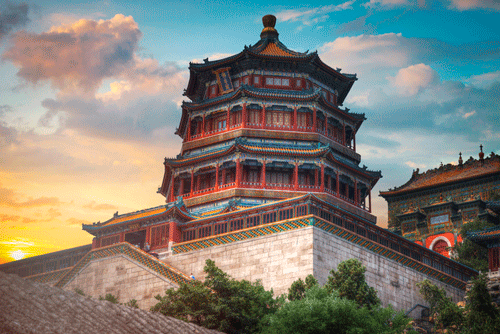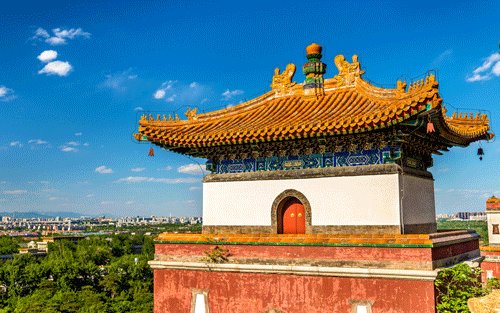Reading Comprehension Text and Exercises
Beijing
The Celestial City
Beijing is the capital city of the People's Republic of China. It is one of the largest cities in the world, with a population of over 21 million people. It is one of the world's leading centers for politics, economics, education, and culture. It is also one of the oldest cities in the world, dating back at least three thousand years.
Click Here for Step-by-Step Rules, Stories and Exercises to Practice All English Tenses
Etymology
The name Beijing means "Northern Capital" in Chinese. The city was given this name in 1403 during the time of the Ming Dynasty. It distinguished the city from the Ming Empire's other major power base, Nanjing (the "Southern Capital").

A Brief History of Beijing
- There is evidence that the ancestors of modern humans lived in the region which is now Beijing for over 250,000 years. The bones of a prehistoric human species called homo erectus were discovered at Zhoukoudian in the 1920s and given the name "Peking Man".
- The first walled city to be built on the site of modern Beijing was Jicheng, the capital city of the state of Ji. This city was built in 1045 BCE.
Jicheng became the capital of its province when the first emperor Qin Shi Huang unified the country in 221 BCE. The city passed under the rule of many different dynasties during the next thousand years. - By 1122 CE, the city was known as Zhongdu and was the capital of the Jurchen Jin dynasty. The city was attacked by a Mongolian army led by Genghis Khan in 1213 and largely destroyed two years later.
Genghis's descendant Kublai Khan built the new city of Dadu to replace the old city between 1264 and 1293. Dadu became the capital of the Yuan dynasty. - In 1368 the city was conquered by the rebel leader Zhu Yuanzhang and renamed Beiping. By 1403, the city had become known as Beijing and was one of the Ming Dynasty's most important power bases.
It was around this time that the city's famous Forbidden City and Temple of Heaven were first built. By 1420, Beijing was the undisputed capital of the Ming Empire. - Beijing was the largest city in the world for most of the 15th, 16th, 17th, and 18th centuries. In 1644 the Ming dynasty was succeeded by the Qing dynasty.
In 1860, parts of Beijing were captured and burned down by French and English forces. They increased European influence in Beijing until the Xinhai Revolution of 1911 which replaced Qing rule with a new Republic of China. - The city fell under the control of the Japanese army in 1937. It was occupied by Japan until the end of the Second World War in 1945.
After the Chinese Civil War came to an end in 1949, Beijing was declared as the capital of the new People's Republic of China led by Mao Zedong. - The city has grown into one of the world's largest and most important cities in the last 30 years. In 2008, Beijing hosted the Summer Olympic Games.
The Great Wall of China
This incredible wall stretches for thousands of miles across the north of China. Construction of the wall began as early as the 3rd century CE under the first Emperor of China, Qin Shi Huang, in order to protect his kingdom from attackers from the north.
The wall has been rebuilt and improved many times over thousands of years. The majority of the existing wall was built during the Ming Dynasty between 1368 and 1644. Visitors to Beijing can take a 40-mile (64 kilometer) trip north to visit the Jinshanling and Simatai sections of the wall.
The Wall is a UNESCO World Heritage Site and is the only human construction that is visible from outer space.
Temple of Heaven
The Temple of Heaven is a complex of religious buildings in the southeastern part of the city center. It was built between 1406 and 1420 during the reign of the Yongle Emperor.
It was visited twice a year by the Emperors of the Ming and Qing dynasties who would pray to Heaven for good weather so that crops would grow well.
At the center of the temple is the Hall of Prayer for Good Harvests where this ceremony would take place. This ceremony was considered to be crucial for the Emperors, who believed that they ruled because they had been granted a mandate from heaven.
Forbidden City
The Forbidden City is a large palace complex in the center of the city. It was built around the same time as the Temple of Heaven to act as the home of emperors and their households.
It acted as the center of Chinese government and political life for over 500 years. The Forbidden City is now home to a large Palace Museum. It was declared a UNESCO World Heritage Site in 1987.
It is listed as holding the largest collection of historic wooden structures in the world. It receives over 15 million visitors each year.
Summer Palace
The Summer Palace is a huge collection of lakes, gardens, and palaces spread over an area of 1.1 square miles (2.9 square kilometers). The central Kunming Lake is entirely man-made and the earth was used to build Longevity Hill where many of the palace's most beautiful buildings stand.
The majority of the palace buildings were constructed in the latter half of the 18th century to act as a place for the Emperor to relax.
Parts of the Summer Palace were damaged by the British in the 1860s and during the Boxer Rebellion of the 1900s. However the site has been restored and renovated in recent years to become one of the city's leading tourist attractions.

An Authentic Beijing Dish
For meat eaters, a visit to Beijing is not complete with sampling its most famous dish, Peking Duck. The duck is roasted and shredded and usually eaten wrapped in small pancakes with spring onion, cucumber and hoi sin sauce.
Comprehension Exercises
Vocabulary Questions
- What does "distinguished" mean?
- frozen or made cold
- set on fire
- made special or separate from others
- What does "launched" mean?
- a person who falls down
- a child or relative of the child of a person
- someone who takes over their parents' business
- What does "prestigious" mean?
- argumentative or disagreeable
- recognized by everyone, not challenged
- shared equally among a group
- What does "illustrations" mean?
- speaking in a pleasing way
- boredom or misery
- power or authority to shape decisions
- What does "manuscript" mean?
- the time of year when seeds are planted
- the time of year when trees are bare and without fruit
- the time of year when crops are collected
Collocation Questions
- The ___________ of the Peking Man was discovered in the 1920s.
- carcass
- body
- skeleton
- Qin Shi Huang was the first ___________ of China.
- Prince
- King
- Emperor
- The Roman geographer Ptolemy ___________ to the area as Eblana Polis.
- capital
- prime
- head
- The Mongol burned the city to the ___________ in 1215 before rebuilding it fifty years later.
- dirt
- earth
- ground
- The city became known as Beijing once it was designated as the northern capital of the Ming ___________.
- tribe
- dynasty
- family
- French and English soldiers ___________ fire to large parts of the Summer Palace complex in 1860.
- set
- game
- match
- Mao Zedong made Beijing the capital of the ___________ Republic of China in 1949.
- Person's
- People's
- Humans
- Parts of the Great Wall of China date ___________ as far as the third century BCE.
- back
- front
- face
- The Emperors of the Ming and Qing dynasties would come to the Temple of Heaven to ___________ for a good harvest twice a year.
- beg
- supplicate
- pray
- The Forbidden City lay at the ___________ of political life in China for over 500 years.
- heart
- lung
- liver
Wh Questions
- What is Simitai?
- an ancient Chinese weapon
- a section of the Great Wall of China
- the name of a Chinese Emperor during the 3rd century BCE
- Why was the Great Wall of China built?
- to protect China from invaders to the north
- to demonstrate the Yongle Emperor's power
- to force prisoners of the Emperor to work
- Where is the Palace Museum located?
- Temple of Heaven
- Summer Palace
- Forbidden City
- How long did it take to build the Temple of Heaven?
- 12 years
- 14 years
- 150 years
- When did the Ming Dynasty come to an end?
- 1654
- 1466
- 1644
Evaluating Statements
- Based on the information in this lesson, which statement is true?
- The Great Wall of China is located around 40 miles north of Beijing.
- The Great Wall of China is located around 80 kilometers south of Beijing.
- Based on the information in this lesson, which statement is false?
- Peking Duck is usually eaten in a pancake with spring onion, cucumber, and hoi sin sauce.
- Peking Duck is usually eaten in a bun with red onion, tomato, and oyster sauce.
True or False?
- Based on the information in this lesson, is the following statement true or false?
"Kunming Lake was made by enlarging an existing pool during the mid-17th century." - True
- False
- Based on the information in this lesson, is the following statement true or false?
"Over 15 million people visit the Forbidden City every year". - True
- False
Answer Key
1. C | 2. B | 3. B | 4. C | 5. C | 6. C | 7. C | 8. A | 9. C | 10. B | 11. A | 12. B | 13. A | 14. C | 15. A | 16. B | 17. A | 18. C | 19. B | 20. C | 21. A | 22. B | 23. B | 24. A
Get Updates, Special Offers, and English Resources
Download your FREE GIFT (the first two chapters of
English Short Stories Book and Workbook)
as soon as you join!

By submitting your email, you consent to receiving updates and newsletters from us and to the sharing of your personal data with third parties for the purposes of sending you communications. We will not spam you. You can unsubscribe at any time. For more information, please see our privacy policy.





